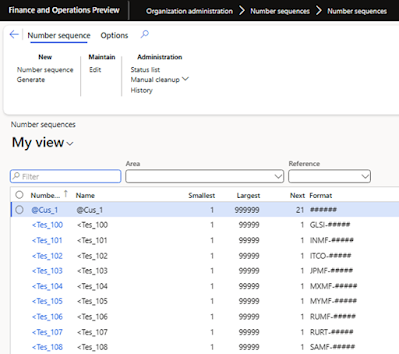Here you can see a listing of all number
sequences already created, you can notice in the Format column the number/pound
symbol (#). This is because number sequences have a dynamic portion to them, so
the # symbol holds the position of the dynamic portion of the number sequence.
The number of #’s used indicate the total size of the sequence, so five #’s
together show that numbers can go from 00001 – 99999.
Within each number sequence, in the ‘Segments’
section you can see the actual different parts to the number sequence. This
field is what makes this slightly unique when trying to create/update this
field in the data entity as the syntax to store this data is fairly complex.
If we export the number sequences via
data entity, the ‘Format’ column stores the human readable overview of what the
number sequence syntax looks like. But the ‘AnnotatedFormat’ column is what
stores the number sequence ‘Segments’ data.
If you click into the field, you can see
that this unique formatting is actually more complex than it initially looks as
there are a combinations of different parameter delimiters mixed with tabs and
new lines.
If we look at the SequenceTables entity
and filter for this number sequence we can see the JSON returned includes all
of the tabs (\t) and new lines (\n) that exist in the Excel file as well:
Creating
New Number Sequences via Data Entity
So given the complexities above,
what is the best way to mass create custom number sequences?
In my opinion, the easiest way to
create these is to manually create an example of each number sequence type you
plan on creating and then look at the output from either the Data Management
Framework export or from the data entity itself which will give you a template
to follow that you can then copy and modify them as needed.
Here is screenshot of the
available different formats:





